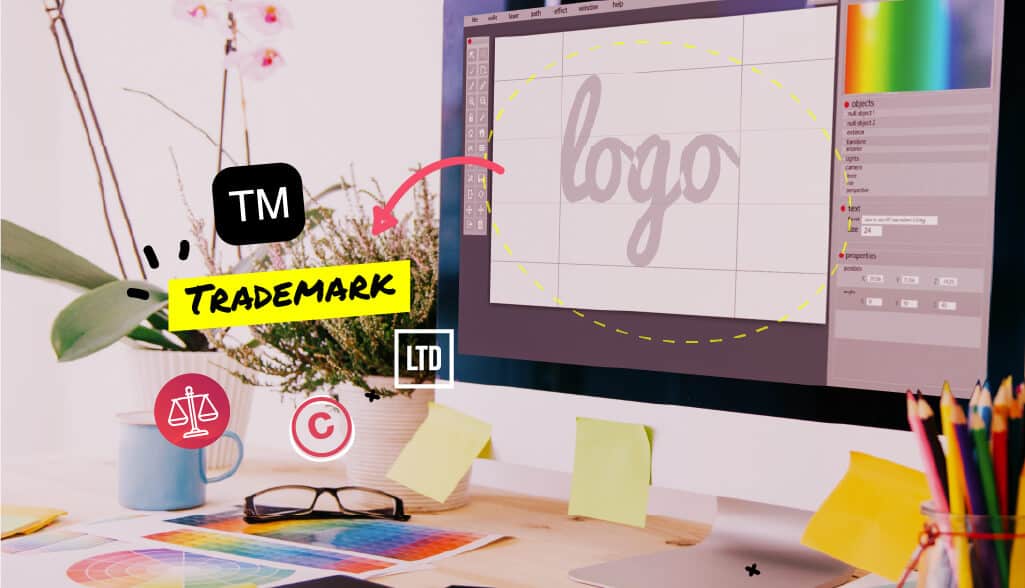
Hauptseite » Blog » Wie man ein Logo markenrechtlich schützen lässt: Alles, was Sie wissen müssen
You’ve put a lot of effort into designing a logo that perfectly represents your brand to the world.
Whether you used a logo maker like Tailor Brands, hired a designer, or designed it yourself, you (hopefully) have a logo you love and are ready to show off.
But, you also need to protect your hard work from shameless thieves who piggyback off other people’s ideas. By registering your brand logo with a trademark, the law will be on your side should anything terrible happen.
If you’re confused about trademark law or just want to know how to trademark your brand logo, keep reading! We’ll break it all down in easy-to-read, bite-sized pieces of info.
Your designs and ideas are, regrettably, at risk of being stolen or copied.
To protect your intellectual property (your non-physical creations such as images, logos, names, etc.), you should trademark your work.
It would be a shame if, after investing so much time and money to develop unique and individual branding elements, someone came along and claimed it as their own, or copied it so much as to be nearly identical. Intentional or not.
For example, Nike uses its swoosh, or tick, to identify its brand to consumers. If someone else were to start using a similar-looking swoosh on their shoes, that would be a breach of Nike’s trademark, as people would think Nike made those shoes.
The crucial part of the law is that your trademark can be infringed upon if another company’s branding assets are so similar to yours that it confuses consumers. If that’s the case, then the infringing party must stop using similar branding elements.
You don’t have to trademark your logo, but there are advantages to doing so. The long-term benefits will not only protect you but can also help you establish a global brand presence.
If your logo is not trademarked, you can still use it freely in your local geographic area. However, this applies to anyone nearby who wants to use a logo that’s similar to yours. There’s not much you can do to stop them except to ask nicely.
But, if your logo is trademarked, you have priority to use it above anyone else. You don’t want others to give your brand, products, or service a bad name. So, play it safe: Trademark your brand logo.
Having a trademark attached to your logo also enables you to take legal action against anyone who uses your design without permission. It’s not unheard of for criminal charges to be brought against the offending party for misusing a trademarked logo.
If you do take someone to court for infringing upon your trademark, you’ll be able to collect money for damages as a result.
Stopping improper use of your logo doesn’t have to end at your county’s borders. With a registered trademark, you can put a stop to any foreign imports that would infringe upon your brand elements.
This is because having your logo trademarked in the US allows you to register your trademark in foreign countries as well—a crucial process if your business will extend outside of national borders.
A trademark will also protect you against cybersquatting, thanks to the federal Anticybersquatting Consumer Protection Act.
Cybersquatting is when people create domain names that are similar to yours but with small differences, such as google.com vs. gooogle.com, or googgle.com
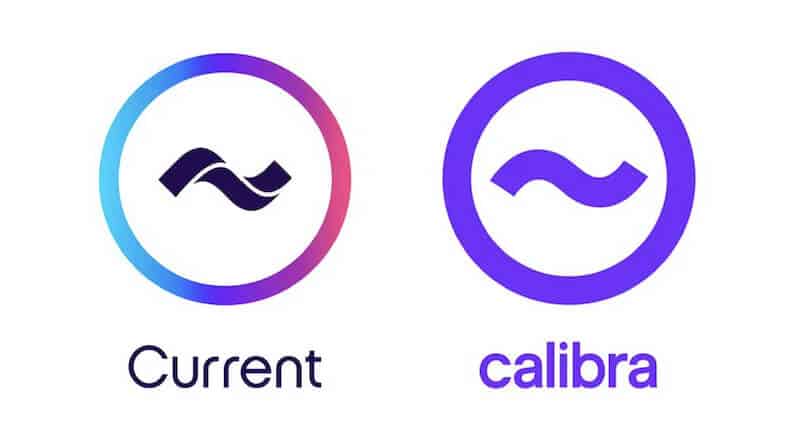
Law: Having a trademark attached to your logo enables you to take legal action against anyone who uses your design without permission. While I hope it never happens to you, if you do take someone to court for trademark infringement, the law is on your side.
Money: Again, hopefully it never happens to you, but if you sue someone for trademark infringement, a registered trademark entitles you to collect money for damages.
Foreign Market: Having your logo trademarked in the U.S. allows you to register your trademark in foreign countries. This is important as it prohibits foreign imports that might infringe upon your trademark.
Just take a look at what happened to Louis Vuitton versus Louis Vuiton Dak! The French fashion house found itself in this exact situation when a fried chicken restaurant used a clearly similar name and a play on their logo.
When Louis Vuitton sent Louis Vuiton Dak a cease-and-desist letter, the restaurant changed their name…to “chaLouisvui tondak” thinking the new name was different enough. (You can’t make this stuff up!) Ultimately, the restaurant owner was fined $12,500 for not complying with the cease-and-desist order.
The takeaway here: The only way to make sure this doesn’t happen to your business is by registering your trademark!
Acquiring a trademark will offer your logo legal protection against misuse by others. Your logo identifies your business to consumers, whether you’re offering a service or products. But there are other types of trademarks as well you should be aware of.
– Service Marks protect companies that provide a service, such as pet groomers or house cleaning. Even though service marks are different from trademarks, they receive the same protections.
– A Suggestive Mark is for when a company name doesn’t automatically describe the type of product or service provided. The Jaguar car company is an example of a suggestive mark. The name Jaguar implies agility and speed, but it doesn’t convey an image of a car manufacturer.
– Fanciful Mark is a logo or name that is different from anything else that already exists. Adidas and Kodak are meaningless words in English, so it’s easy for them to receive a fanciful mark.
– Arbitrary Mark is for when a name or phrase already has a well-known meaning, but it’s different from the way the company is using it. An apple is a popular fruit, but Apple, the tech company, uses the name in such a way that is different from the general use of the word Apple.
– Generic Mark can’t be given to generic names such as “The Shoe Store.” Trademarking such a vague name would restrict all other shoe shops. Instead, it must describe characteristics, qualities, or something else unique that your business sells or offers.
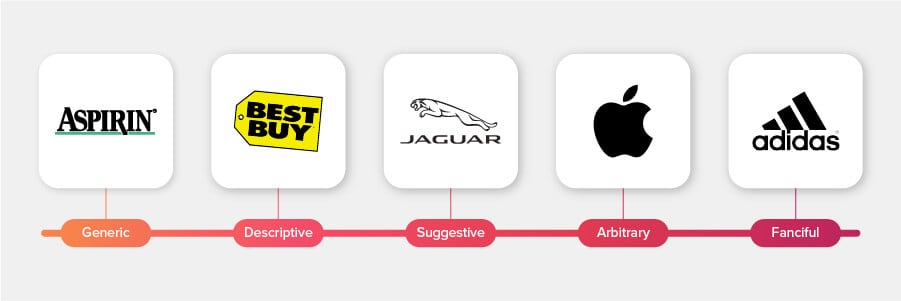
Fanciful trademarks are made-up words. The word holds no other meaning aside from its relation to the good or service the business provides. Think about it this way: If you look up the word ‘Adidas’ in the dictionary, it doesn’t exist. That’s because the sneaker and athleisure brand invented the word!
Arbitrary trademarks are actual words that have no correlation with the good or service of the business. Consider tech-giant Apple. The popular fruit has absolutely no association with the goods the company Apple provides.
Suggestive trademarks hint at the type of product or service provided, but does not quite reveal it outright. Let’s take the Jaguar Car company. The trademark gives the impression that driving a Jaguar vehicle will be as fast as a big cat.
Descriptive trademarks describe some aspect of a good or service, such as its quality, characteristics, function or purpose, without distinguishing it in any tangible way. Sure, a retailer that sells teddy bears could call themselves “cute”, but Build-A-Bear Workshop is a much more effective mark.
Generic trademarks are the general name for your goods or services. If you are a candle making business and attempt to trademark the word “candle”, there’s a very good chance it will be rejected. After all, the purpose of a trademark is to differentiate your brand from another in the market, and if everyone in the candle-making business trademarked “candle” then customers would be pretty confused.
Okay, so you’ve made the decision to trademark your logo.
Now you have to consider which of the different levels of trademark protection you want for your logo. The level of trademark protection determines the cost as well as the scope of your rights.
Here are the different types of trademark protection:
Also known as common law trademark, you don’t have to register a logo for a trademark to use it. You’ll receive common law trademark protection for your logo as soon as you begin using it, in let’s say, everyday business transactions or advertising.
However, the extent of protection is restricted to your local area. This means your trademark rights are only protected within the particular location you are using it.
So that logo for the homemade soy candles you sell in your neighborhood can only be enforced in that specific area.
A common law trademark should be marked with either the ™ mark or SM mark. The ™ mark is used for product-based trademarks. The SM mark is used for service-based trademarks.
Both marks inform other businesses that you own your logo (although with limited protection). In order to receive national protection for your trademark, you need to register it with the USPTO, which I’ll cover later on.
Registering your trademark within a U.S. state offers protection only in that specific state.
If you conduct business in just one state, this level of protection should be enough. But if your business expands across state borders where your trademark is not registered, it is no longer protected. Any protection stops at state lines.
Scenario: Your soy candle business is booming in your hometown in Georgia and you want to try selling in Florida. It is then your responsibility to prevent other candle businesses in Florida from using your trademark.
A federal trademark offers protection nationally across state lines. Many online businesses, for example, would need a federal trademark since the business will sell goods across state lines.
Here’s the good news: A federal trademark allows you the greatest legal protections. If the U.S. Patent and Trademark Office (USPTO) accepts your application, your logo will be on the Principal Register list.
This comes with a lot of benefits, including:
Note that the USPTO application process is lengthy and complicated. That being said, I will break down the process for you in a bit.
The difference between a trademark and copyright can be confusing at first because they both provide protection. And, to confuse matters even more, you can both trademark and copyright a logo.
A trademark protects your brand elements that represent your name or company, such as symbols, logos, taglines—sometimes even a mix of each. These elements are often also used for advertising, documentation, and other online and offline uses.
A copyright protects creative pieces of work such as books, audio, movies, or computer applications. You can’t get a copyright for just an idea; it must at least be tangible somehow, usually physically or digitally.
If your logo includes originally designed art, it may be eligible for both copyright and trademark, to give you full protection from competitors.
Simply coming up with the logo idea does not give you rights in the design. Whoever buys the design is the owner of the trademark.
That means if you’ve designed your own logo, you own the trademark. However, if you’ve hired a designer to make your logo for you, the trademark becomes yours only once you buy it from the creator.
Luckily, once you own your trademark, you have full say over your logo – including edits, where it shows up, and even how others are allowed to use it.
Still kinda confused? Let me clarify with an example.
An ongoing legal battle between the band Nirvana and fashion designer Marc Jacobs involves the iconic smiley face recognized the world over for its X’s for eyes and tongue hanging out from its crooked grin.
Nirvana LLC filed a lawsuit claiming Marc Jacobs’ “intentional copy” of the smiley with minor alterations for his clothing line. Nirvana’s lawyers said the image was registered for copyright in 1993 and declared full ownership of the image.
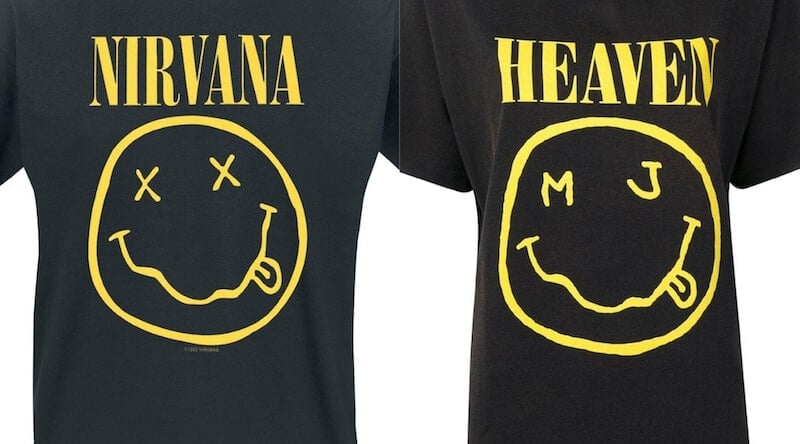
To make matters more complicated, an artist stepped forward claiming both authorship and ownership of the smiley face, which he says was originally created as a favor to Nirvana in 1991, and claims he is the rightful owner.
However, it doesn’t matter—the band registered the logo as a trademark back in ‘93 under Kurt Cobain’s name and so it belongs fully to him.
There are two trademark symbols you can use to protect your designs: ™ and ®. These symbols let people know that you’ve claimed ownership of your designs.
You don’t have to use these symbols in your logo (in fact, we recommend not including them, as they can hurt a clean design), but they do make it evident that your logos are protected.
Here’s how to add trademark symbols using a Windows computer or Apple Mac Windows:
| Symbol | Windows | Mac OS |
| ™ | ALT + 0153 | OPTION + 2 |
| ® | ALT + 0174 | OPTION + R |
As with most things in life (unfortunately), the trademark process costs a (not so) pretty penny. Let’s just rip the bandaid off and talk numbers.
The cost of registering a logo for a trademark varies by country and the level of protection (local, state, or federal) you choose.
Local trademark doesn’t require you to pay anything for the trademark application.
State trademark costs depend on the state, ranging from $30 in Alabama to $70 in California. You can check your state’s official website to find out the exact cost.
Federal trademark fees vary depending on 3 factors:
If you want to find out more about trademark fees, I recommend checking this out.
Now let’s talk about legal fees.
There are benefits of using a lawyer, one of them being they are savvy investigators. A lawyer can determine quite easily if your logo or business name belongs to someone else, as well as help get your application approved.
However, a lawyer can charge anywhere from $500 to $2,000.
To ensure that no one else is already using a logo design that’s similar to yours, you can search the United States Trademark Electronic Search System (TESS). It’s an online database that holds all of the currently registered trademarks.
There are specialists such as trademark attorneys who are experts in the research phase of the process. It may seem simple to do, but there are particular methods they use to ensure you aren’t using someone else’s design, even if it’s unintentional.
If there are any logos that already exist which are similar to yours, including any misspellings, it means you won’t receive approval for your trademark.
Your logo represents your brand and the time and money invested in your company. By trademarking your logo, you’re protecting your brand from shameless copycats and showing your customers that you mean business.
The application will prompt you to describe the goods or services your logo represents. If you fail to do so—or if the logo does not clearly represent the type of product it claims to sell—the USPTO will reject your application.
So when I say you’ll need to describe the good or service, I mean really get into detail. The USPTO has 45 different classes that your good or service might fall under. For example, one category includes precious metals such as jewelry; another incorporates musical instruments.
Again, it is really important to classify your product using precisely the right words. Otherwise, your application might be denied.
A specimen is a sample of your trademark as used in commerce. It’s the physical evidence of how you’re using your trademark.
If your logo represents a physical product like a candle, you’d provide a photo of your logo on the candle itself, a photo of the packaging or tags used for the candle, or a photo of the candle on display in a store.
What not to use as a specimen:
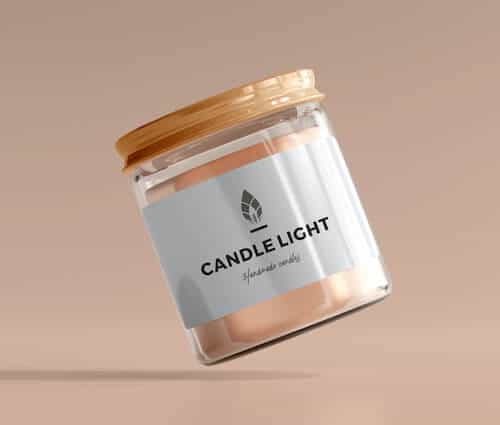
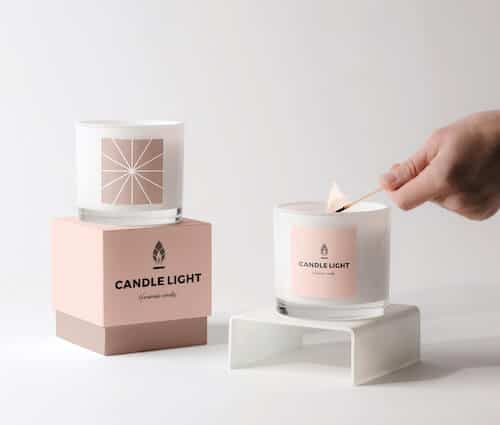
What not to use as a specimen:
The product specimen must present evidence of a transaction between you and your customer.
The rules change slightly if you offer a service (it’s even easier!). All you need to supply is materials used to advertise your business. The logo and service you offer must show a direct association.
If you provide a service such as delivering custom-made candles to special events, you would simply supply an invoice or a screenshot of the website where you offer your services.
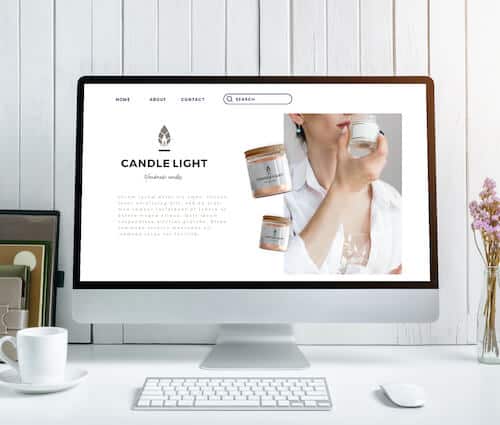
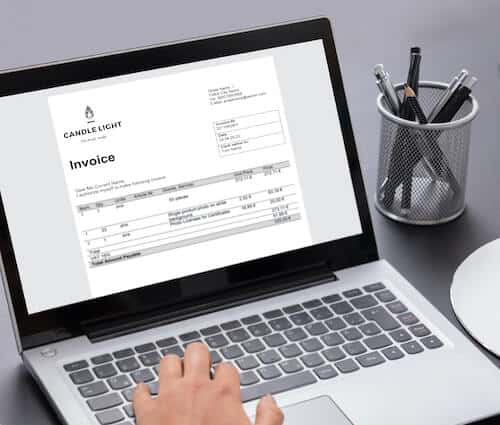
If you have more than one good or service associated with your logo, you’ll need to submit a specimen for each type. And, of course, there are fees for each.
At this point, you’ve completed the process. All the documents are in order, the forms are filled, and you are ready to hit submit.
Now the waiting game begins.
Don’t be concerned if you don’t hear back right away. It takes anywhere from 6 months to one year to receive the final decision.
Until then, you can check on the status of your application in the Trademark Status and Document Retrieval database, as well as check the current processing times for applications.
If you’re missing any basic filing requirements, the agency will notify you. If there are any minor issues with your application, you might receive a call or email. But if there is a more involved concern, you’ll probably receive a letter called an Office Action that outlines the reasons your application was denied.
If the USPTO rejects your application due to an issue that is resolvable, you can fix the problem. But if the agency refused your application because of a similarity to an existing trademark, you’ll have to start the process all over again.
After receiving an Office Action letter, you have 6 months from the date of mailing to make the corrections. If your submission is denied yet again, you’ll be issued a final refusal of your application.
You can appeal the denial to the Trademark Trial and Appeal Board (TTAB), which is an administrative court with the USPTO. However, that will involve additional fees.
Once you have a registered trademark (hooray!), you’ll have to take some other actions.
To maintain your trademark rights, you need to submit a Trademark Declaration of Continued Use and a Trademark Renewal to the USPTO every 5 years. If you don’t do so, you’ll still have a 6 month grace period (with additional fees, as usual).
But if that grace period passes and you still don’t submit those forms, the USPTO will strip all of your legal intellectual property protections.
Keep in mind that as long as your logo is in commercial use, you can renew your trademark an unlimited number of times.
Misuse of a trademark by competitors happens all the time—even to the biggest companies. Remember the Louis Vuitton versus fried chicken restaurant story I mentioned earlier?
To protect your logo and make sure no one else is using it, you’ll need to monitor your trademark. There are attorneys and companies who specialize in handling this sort of thing. If someone is using your logo or trying to trademark a logo that is too similar to yours, they’ll send a cease and desist letter. A trademark watch is usually necessary for larger businesses.
Most small businesses don’t use this type of service, but rather keep an eye out for trademark infringement themselves.
If someone is using your logo or attempting to trademark a logo that is too similar to yours, here’s what you can do:
If you find your trademark being infringed upon, you can send the infringer a cease and desist letter demanding that they stop using the mark. Infringement lawsuits are expensive, so most people will comply.
But if the infringer keeps using the mark, you can file a lawsuit. If your mark is registered with the USPTO, you can file a lawsuit in federal court. If your mark is unregistered and it’s protected on a state level, it’ll go to the state court.
In an infringement lawsuit, there must be a likelihood of confusion, meaning the mark is used in connection with the same goods like computer technology, let’s say.
You can sue if your mark is well-known and any other use of it will weaken the mark’s reputation. Dilution lawsuits can only be used when the mark is famous.
It’s different from an infringement lawsuit because the rules of dilution apply when the mark in issue is used in connection with 2 very different goods, such as candles and cookies.
You already have the crucial element to starting a successful business: a logo.
Your next step is to trademark your logo to ensure the uniqueness of your business is protected. A trademark can improve product recognition and promote customer loyalty while protecting your logo against infringement.
The trademark registration process is complex and technical, but doing so is essential for your business’s success.
Follow this guide step-by-step and you can rest assured that your logo will remain as the unique, memorable visual representation of your business for years to come.
This portion of our website is for informational purposes only. Tailor Brands is not a law firm, and none of the information on this website constitutes or is intended to convey legal advice. All statements, opinions, recommendations, and conclusions are solely the expression of the author and provided on an as-is basis. Accordingly, Tailor Brands is not responsible for the information and/or its accuracy or completeness.
Products
Resources
@2024 Copyright Tailor Brands